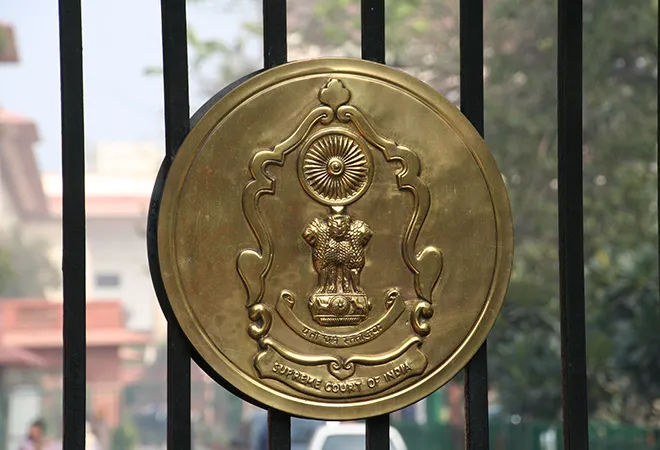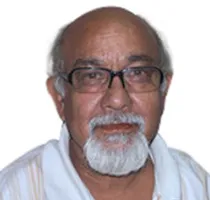-
CENTRES
Progammes & Centres
Location
There is a huge backlog of cases that are awaiting to be heard and processed for final verdicts.

Image Source: Ramesh Lalwani/Getty Images
Turf war between the executive and the judiciary, which began as early as 2014 with the enactment of the National Judicial Appointments Commission (NJAC) and the apex court striking down in 2015, has taken a very heavy toll on the functioning of the judicial system with delays in the delivery of justice compounding.
Successive Supreme Court chief justices along with other fellow justices have been highlighting the issue and have been underlining the significance to resolve all outstanding issues with the executive but irrespective of the ideological colour of the political dispensation, judicial reforms have failed to gain traction with the political parties resulting in widespread disillusionment with the system.
The Supreme Court, possibly taking a conscious note of the government unwillingness to come forth to resolve issues of delay, has decided to take the initiative to set things right as far as possible so that it does not stand as accused in the people’s court.
In a far-reaching judicial order, a two-member bench of the country’s highest court on December 10 asked both the government as well as its own Collegium to ensure that names on which the Supreme Court Collegium, the High Courts and the governments had agreed upon should be appointed within six months.
“If recommendations of the High Court Collegium meet with the approval of the Supreme Court Collegium and the government, at least their appointments must take place within six months. This is not to say that in other cases the process should not be completed within six months,” a bench of Justices Sanjay Kishan Kaul and K.M. Joseph said in an order dated 6 December that was made available on 10 December.
The order is significant in many respects particularly seen in the background of high pendency of cases in several High Courts of the country. Data shows that 38% of all sanctioned posts for High Court judges are lying vacant as of 1 December, with Rajasthan and Andhra Pradesh high courts functioning at below half their actual capacity.
There is a huge backlog of cases that are awaiting to be heard and processed for final verdicts. At present, sanctioned strength in high courts is 1079 while they have been working with 669 justices only. Thus, there are 410 vacancies with 213 recommendations awaiting final clearance either of the government or of the SC Collegium. Names for remaining 197 vacancies are yet to be received from High Court collegiums.
The court has noted in its order that in 2019, only 65 judges to the HCs came to be appointed as on 2 December as against 115 in 2017 and 108 in 2018. Such delays, the court observed, could lead to a “judicial jam” in the HCs as the apex court has already streamlined the process for appointment in lower judiciary and more appeals are likely to be filed in HCs in coming time.
According to memorandum of procedure for appointment of judges in the high courts and the apex court, appointments should be initiated at least six months before a vacancy arises and six weeks of time is then specified for the State to send recommendation to the Union Law Minister, after which the brief is to be sent to the Supreme Court collegium in four weeks. Once the collegium clears the names, the Law Ministry needs to put up the recommendations to the Prime Minister in three weeks who will in turn advise the President. Thereafter, since no time limit is prescribed, delays invariably takes place at this level bringing the process to a standstill.
In its order therefore, the apex court has underscored that the appointments required “a continuous, collaborative and integrated process, where the government is an important consultee.”
The highest court of the country, acting responsibly in full realisation of its duty towards the Constitution and the people, has asked the Attorney General K.K. Venugopal to provide data on when the process was initiated and time taken by various authorities to clear the names. The court further said that it will confine its proceedings to 213 names with the government and the SC collegium. In its order, the Supreme Court has stressed that data will help to determine how to streamline the system and prevent delays in future.
Earlier last week, the same bench of the apex court had pulled up the government for not acting on another set of nominations on which the government had sent back objections. If the collegium reiterates the names, the court had pointed out, the government has no option but to appoint the judges.
Such standoffs have become more frequent that were earlier exception. Strange but true that people at large are suffering because of the ongoing tussle rather a battle of supremacy between the executive and the judiciary. In the prevailing scenario, there is an added responsibility on the top court to take firms steps to ensure that the collegium system that is has fought hard to preserve and protect, with all its flaws and frailties, functions effectively.
If the judiciary, though a self-correcting route, succeeds in addressing the backlog so that speedy, quick, inexpensive and responsive justice system could be made available to the people, it will then indeed emerge as people’s hero.
The views expressed above belong to the author(s). ORF research and analyses now available on Telegram! Click here to access our curated content — blogs, longforms and interviews.

Satish Misra was Senior Fellow at ORF. He has been a journalist for many years. He has a PhD in International Affairs from Humboldt University ...
Read More +